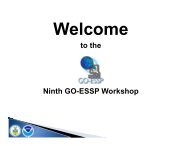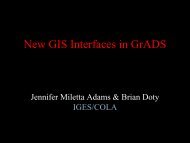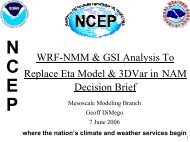Appendix C: <strong>The</strong> Data AccessTo address a growing need for remote access to high volume numerical weatherprediction and global climate models and data, <strong>NOAA</strong>’s <strong>National</strong> Climatic Data Center(NCDC), along with the <strong>National</strong> Centers for Environmental Prediction (<strong>NCEP</strong>) and theGeophysical Fluid Dynamics Laboratory (GFDL), initiated the <strong>NOAA</strong> OperationalModel Archive and Distribution <strong>System</strong> (NOMADS, Rutledge, et al., 2006) project. <strong>The</strong>NOMADS framework was developed to facilitate climate model and observational datainter-comparison capabilities as discussed in documents such as the IntergovernmentalPanel on <strong>Climate</strong> Change (IPCC, 2001), and advances a direct recommendation by the<strong>National</strong> Academies of Science, Board on Atmospheric Sciences and <strong>Climate</strong> (BASC) toimprove multi-model ensemble diagnostics capabilities (<strong>National</strong> Academies of Science,NRC, 2007).Of the 250Tb CFSR total output (estimated at the time of this writing),approximately 10Tb are considered to be the “Tier-1” or “high priority” data. <strong>The</strong>se datawere determined by several requirements workshops conducted by <strong>NCEP</strong>, and at anNCDC hosted <strong>Reanalysis</strong> Town Hall Workshop at the January 2008 Annual Meeting ofthe American Meteorological Society. At the AMS meeting NCDC obtained feedback onuser requirements for this massive dataset. An outcome of that Workshop culminated inthe generation of a user web page soliciting additional user requirements. <strong>The</strong> <strong>NOAA</strong><strong>Reanalysis</strong> Community Web Forum can be accessed at:http://nomads.ncdc.noaa.gov/<strong>NOAA</strong><strong>Reanalysis</strong>/cfsrr.<strong>The</strong> primary <strong>NOAA</strong> access point for CFSR is NCDC NOMADS located at:http://nomads.ncdc.noaa.gov. On NOMADS data access to CFSR is facilitated by fileand variable type organization most requested by users based on previous reanalysisoutputs. <strong>The</strong> “Tier-1” data include a suite of variables aggregated in a long time-series,and a suite of monthly mean variables. <strong>The</strong> monthly mean and time series data areavailable as separate files by variable type, month and year for the period of record tofacilitate user access. A separate dataset of monthly mean data have been aggregated foraccess as individual files of specific type so users can make a single request for the entireperiod of record of individual variables (e.g., 31 years of 500hPa heights). <strong>The</strong>se “longtime-series” datasets will greatly reduce processing time on the NCDC NOMADS whilealso providing improved user access response times.To facilitate user access the <strong>National</strong> Center for Atmospheric Research(NCAR) has agreed to act as a mirror site to the NCDC's NOMADS access point and isscheduled to provide access to CFSR. <strong>The</strong> NCAR access point is: http://dss.ucar.edu/.Given the massive volume of these data, users are cautioned that extremely highvolume data requests may be throttled at NCDC based on the size of the individualrequest and the number of concurrent users.- 64 -
Appendix D: Details of Satellite bias correction spin up experiments for CFSRThis CFSR covers the period from 1979 to 2008. During these 30 years, a series of<strong>NOAA</strong> polar orbiting satellites operated for periods of these years (Figure 21). <strong>The</strong>radiance measurements from these satellites were directly assimilated into the analysissystem, which is one of the major improvements of the CFSR over R2. Substantial biasesexist when the radiance measurements are compared to the model-simulated radiances.<strong>The</strong>se biases are complicated and relate to instrument calibration, data processing anddeficiencies in the radiative transfer model. Accurate bias corrections for these satelliteobservations were required for the success of the CFSR. This part of the paper describesthe method to estimate the biases of these historical satellite observations.A variational satellite bias correction scheme was introduced by Derber and Wu(1998) when direct assimilation of radiance began. This scheme has been continuallydeveloped at <strong>NCEP</strong> since then and is used in the GSI system adapted for the CFSR.Radiance bias is composed of two parts: the satellite scan angle dependent bias(SATANG) and the air-mass dependent part (BIASCR). <strong>The</strong> SATANG file is updatedfollowing the analysis step as the weighted average of the previous cycle’s SATANG file(containing the bias) and the departure between the new radiance measurements and themodel-simulated radiances, o-g, (where o is the observation and g is the forecast guess).SATANG is allowed to evolve very slowly (the weight given to the new (o-g) is 1/120).<strong>The</strong> air mass bias is predicted as the linear combination of five predictors and theircorresponding coefficients, the BIASCR file. <strong>The</strong> five predictors are, respectively, aconstant 0.01, the solar zenith angle, the cloud liquid water, CLW, (only applied tomicrowave instruments), the temperature lapse rate and the square of the lapse rate. <strong>The</strong>predictor coefficients are calculated using the variational method (the predictorcoefficients are additional analysis variables and included in the minimization).<strong>The</strong> biases from the historical satellite radiances can be estimated using a two-stepprocedure. First, the GDAS is run for a training period, starting from guess values, andthe statistics of the (o-g) are collected throughout this training period. Second, thecollected radiance statistics are then post-processed to calculate a SATANG file. For agiven scan position, channel, sensor, and satellite, the SATANG value is the average ofthe (o-g) weighted by the specified observation error inverse over the whole globe andthe entire training period.Several preliminary experiments have been carried out to determine startingvalues and how long the training period should be. <strong>The</strong>se experiments were run over theperiod of 2006110118 to 2007013018 using zeroed out SATANG and BIASCR files. Tosimulate historical MSU and HIRS2 channels 2-14, only AMSUA-N15 channels 3, 5, 7and 9 and HIRS3-N17 channels 2-14, respectively, were assimilated. (<strong>The</strong> CRTM SSUcell pressure correction noted in section 3.1.2 was still in development while these testswere run.) <strong>The</strong> weight given to the new (o-g) is 0.033 which is larger than 0.00833 usedin the analysis, since the purpose was to spin up the bias correction. <strong>The</strong> preliminaryexperiments show that the predictor coefficients, except for the CLW term, can start fromzero and spin up rapidly, usually within a month (not shown). <strong>The</strong> coefficients for theCLW evolve very slowly, as shown in Figure 25, thus, the CLW coefficients from<strong>NOAA</strong>-15 are used as guess values of the training period for all the historical MSUchannels.- 65 -
- Page 2 and 3:
ABSTRACTThe NCEP Climate Forecast S
- Page 4 and 5:
1. IntroductionThe first reanalysis
- Page 6 and 7:
In this paper we only discuss globa
- Page 8 and 9:
the reanalysis was halted to addres
- Page 10 and 11:
online archive of data for reanalys
- Page 12 and 13:
density MESONET data is included in
- Page 14 and 15: The 1B datasets were calibrated usi
- Page 16 and 17: MetOp is Europe's first polar-orbit
- Page 20 and 21: The third GSI feature enabled in th
- Page 22 and 23: the hydrostatic assumption. Soon af
- Page 24 and 25: esolution with 28 sigma layers in t
- Page 26 and 27: SW and LW radiations at one-hour in
- Page 28 and 29: SST data. The other uses AVHRR and
- Page 30 and 31: y Gent and McWilliams (1990; see al
- Page 32 and 33: from the Global Temperature-Salinit
- Page 34 and 35: through the end of the data set in
- Page 36 and 37: The passive microwave weather filte
- Page 39 and 40: from the sea ice/ocean back to the
- Page 41 and 42: weight is assigned to the gauge ana
- Page 43 and 44: Stream 6: 1 Jan 1994 to 31 Mar 1999
- Page 45 and 46: in the mid 1990’s, the period whe
- Page 47: e due to a change over the oceans (
- Page 52 and 53: In Figure 49, we show the temporal
- Page 54 and 55: distributed in time and space. Desp
- Page 56 and 57: forecast model at a lower resolutio
- Page 58 and 59: Appendix A: AcronymsAER Atmospheric
- Page 60 and 61: ONPCMDIPIRATAPROFLRQBOQuikSCATR1R2R
- Page 62 and 63: TMP2M 2m air temperature 24 / 473TM
- Page 66 and 67: Figure 26 shows the global total bi
- Page 68 and 69: Argo Science Team, 2001: The global
- Page 70 and 71: Compo, G.P., J.S. Whitaker, and P.D
- Page 72 and 73: ozone Mapping and Profiler Suite (O
- Page 75 and 76: Global Forecast System. Manuscript
- Page 77 and 78: and climate models. Atmos. Chem. Ph
- Page 79 and 80: performance Earth system modeling w
- Page 81 and 82: with mesoscale numerical weather pr
- Page 83 and 84: experiments using SSM/I wind speed
- Page 85 and 86: Figure 21: Same as Figure 2, but fo
- Page 87 and 88: Figure 45: The fit of 6-hour foreca
- Page 89 and 90: Figure 1: Diagram illustrating CFSR
- Page 91 and 92: Figure 3: Same as in Figure 2, but
- Page 93 and 94: Figure 5: Same as in Figure 2, but
- Page 95 and 96: Figure 7: Same as in Figure 2, but
- Page 97 and 98: Figure 9: Same as in Figure 2, but
- Page 99 and 100: Figure 11: Same as in Figure 2, but
- Page 101 and 102: Figure 13: Same as in Figure 2, but
- Page 103 and 104: Figure 15: Radiance instruments on
- Page 105 and 106: Figure 17: Same as in Figure 16, bu
- Page 107 and 108: Figure 19: Global average Tb first
- Page 109 and 110: Figure 21: Same as in Figure 16, bu
- Page 111: Figure 23: Comparisons of the SSU b
- Page 114 and 115:
Figure 26: The global total bias fo
- Page 116 and 117:
Figure 28: The yearly total of trop
- Page 118 and 119:
Figure 30: The vertical structure o
- Page 120 and 121:
Figure 32: The global number of tem
- Page 122 and 123:
Figure 34: The same as Figure 33, b
- Page 124 and 125:
Figure 36: Monthly mean Sea ice ext
- Page 126 and 127:
Figure 38: 2-meter volumetric soil
- Page 128 and 129:
Figure 40: Schematic of the executi
- Page 130 and 131:
Figure 42: Yearly averaged Southern
- Page 132 and 133:
Figure 44: Monthly mean hourly surf
- Page 134 and 135:
Figure 46: Global mean temperature
- Page 136 and 137:
Figure 48: Zonal mean total ozone d
- Page 138 and 139:
Figure 50: The subsurface temperatu
- Page 140 and 141:
Figure 52: Vertical profiles of the
- Page 142 and 143:
Figure 54: Zonal surface velocities
- Page 144 and 145:
ProgramPREVENTSACQCACAR_CQCCQCCQCVA
- Page 146:
Satellite Starting date Ending Date





